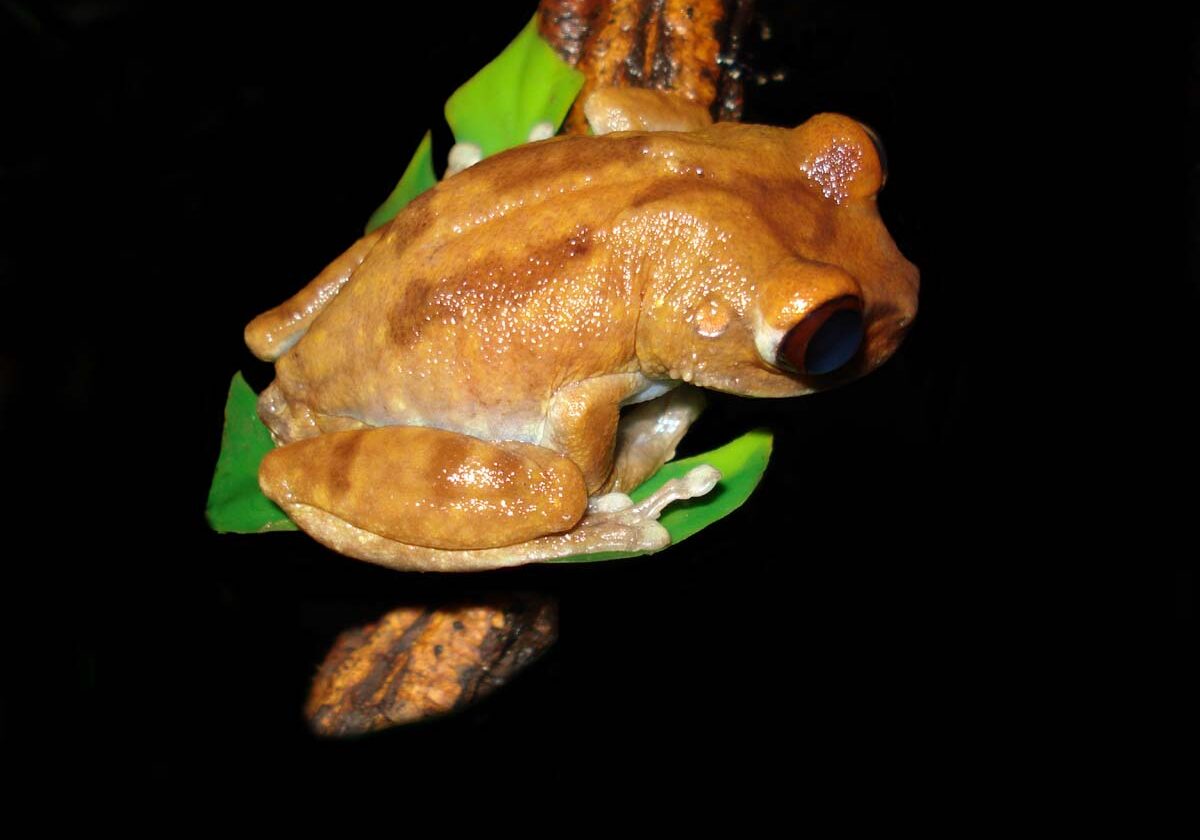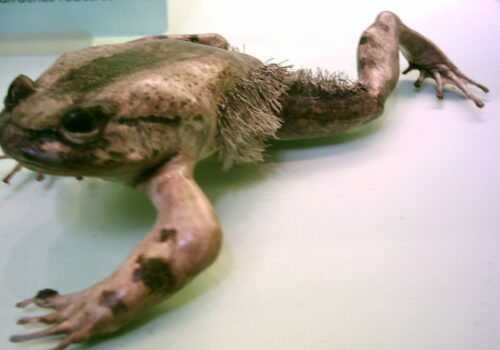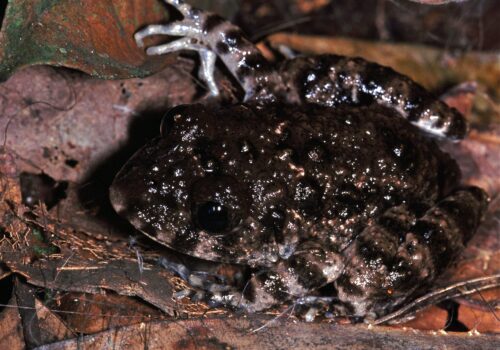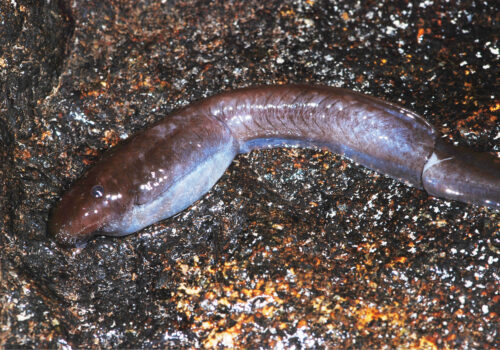- Introduction: An Enigmatic Beauty from the Mist Forest
- Taxonomy and Classification: Understanding the Uluguru Frog's Heritage
- Natural Habitat: Life Among the Clouds in Tanzania's Forest Highways
- Physical Characteristics: A Frog Shrouded in Camouflage and Patterns
- Behavior and Life Cycle: A Symphony of Calls in the Misty Night
- Ecological Role: Guardians of Biodiversity and Indicators of Forest Health
- Threats and Conservation Status: Facing the Race Against Time and Habitat Loss
- Cultural and Scientific Significance: Amphibians as Symbols of Life and Balance
- Conclusion: Ensuring the Legacy of Leptopelis uluguruensis
Introduction: An Enigmatic Beauty from the Mist Forest#
High in the misty forests of Tanzania’s Uluguru Mountains, nestled beneath emerald canopies and hidden among moss-laden trees, lives a delicate amphibian whose very existence whispers tales of ancient ecosystems untouched by time. Leptopelis uluguruensis, commonly known as the Uluguru Forest Tree Frog, is a species whose quiet presence belies its immense ecological and scientific significance. Despite living hidden in shadows and mist, scientists, conservationists, and nature enthusiasts alike are drawn to its distinct charms.
This frog was first formally described by Barbour and Loveridge in 1928, yet even today, it remains one of nature’s captivating, yet secretive, mysteries. Its gentle nocturnal chorus echoes softly through the foothills, carrying the legacy of countless generations and serving as an ethereal reminder of the fragile balance within these forests. Let us journey together into its world and uncover the secrets held by a tiny frog whose life speaks volumes about biodiversity, conservation, and coexistence.
Taxonomy and Classification: Understanding the Uluguru Frog’s Heritage#
The Leptopelis uluguruensis resides within the family Arthroleptidae, a diverse group comprising tree frogs native to Sub-Saharan Africa. Within the genus Leptopelis, it’s closely related to species such as Leptopelis barbouri and Leptopelis parkeri, reflecting a fascinating evolutionary lineage adapted distinctly to Africa’s unique habitats.
The genus name “Leptopelis” stems from Ancient Greek roots, meaning “slender foot,” aptly capturing the delicate, elongated limbs these tree frogs utilize for adept navigation of their arboreal habitats. Species-specific designation “uluguruensis” proudly marks the species’ strong ties to its geographic heritage—the Uluguru Mountains, a key biodiversity hotspot in Eastern Africa.
Natural Habitat: Life Among the Clouds in Tanzania’s Forest Highways#
The Uluguru Mountains: A Forest Sanctuary#
Perched atop Tanzania’s eastern arc mountains, the Uluguru Mountains rise dramatically, cloaked in evergreen rainforests often kissed by mist and clouds. These mountains shelter a remarkable aggregation of biodiversity and endemic species, among them our elusive tree-dwelling protagonist, the Uluguru Forest Tree Frog.
Inhabiting humid montane forests between approximately 1500 to 2300 meters above sea level, this species thrives primarily amidst thick, moss-laden vegetation, and dense arboreal canopies. These elevation-specific ecosystems provide the moisture and moderate temperatures necessary for the frogs’ sensitive skin, ensuring their survival and reproductive success.
A Perfect Microhabitat: Delicate Balance and Dependency#
The Uluguru frog’s microhabitat comprises leaf-littered forest floors, tree trunks draped in epiphytes and mosses, and low-hanging understory foliage—each a crucial component offering protection, food, and breeding niches. The dense foliage maintains necessary humidity, enabling successful egg development and tadpole survival. This delicate habitat, incredibly sensitive to disturbance, highlights a tight ecological dependence and emphasizes why habitat preservation is essential for sustaining this species.
Physical Characteristics: A Frog Shrouded in Camouflage and Patterns#
Though modest in size, typically measuring between 3 to 5 centimeters, Leptopelis uluguruensis exhibits striking physical traits expertly evolved to fit its arboreal lifestyle. Its body displays graceful and streamlined proportions, with slender limbs ending in round adhesive discs that afford excellent grip on damp surfaces and smooth leaves.
A distinctive aspect of its coloration includes shades of vibrant green subtly interwoven with darker spots or blotches, occasionally boasting brownish hues when blending seamlessly into lichens and moss-covered bark. Reflective metallic flecks adorn their eyes, complete with horizontal-shaped pupils designed to optimize vision during twilight and nighttime hours.
This sophisticated camouflage helps conceal this species against predatory threats such as birds and snakes. Yet, their often distinctly marked patterns aid researchers in identifying and monitoring populations, furthering conservation awareness and efforts.
Behavior and Life Cycle: A Symphony of Calls in the Misty Night#
Mating and Vocalizations#
Nightfall signals an enchanting transformation in the Uluguru forests. Male Leptopelis uluguruensis perch strategically on branches, leaves, or sheltered vegetation, emitting gentle calls distinctive in pitch, tonal quality, and rhythm. These subtle choruses echo through the misty darkness, attracting females and dictating individual territorial boundaries.
From Eggs to Tadpoles: Life Amidst Moisture and Moss#
Female frogs lay carefully placed egg masses directly onto moist vegetation or tree bark suspended above small pools of collected rainwater, ensuring safety and required moisture. Upon hatching, the tadpoles drop into waiting pools below or trickle down rainwater trails, beginning their lives as herbivorous consumers of detritus, algae, and biofilm. Their rapid growth and metamorphosis offer reassurance that conditions remain conducive to amphibian populations within this sensitive ecosystem.
Ecological Role: Guardians of Biodiversity and Indicators of Forest Health#
Despite their diminutive stature, Leptopelis uluguruensis play an essential ecological role. As insectivores, they regulate insect populations, including mosquitoes, moths, beetles, and others, thus preserving balanced predator-prey relationships in their ecosystem. Simultaneously, they themselves act as vital prey to snakes, birds, and larger mammals—forming critical links within complex food webs.
Perhaps their most valuable ecological contribution is as sensitive bioindicators. Amphibians readily reflect environmental changes through declining numbers driven by environmental degradation or pollution, making them frontline indicators of habitat and ecosystem changes essential to monitoring efforts.
Threats and Conservation Status: Facing the Race Against Time and Habitat Loss#
The International Union for Conservation of Nature (IUCN) currently categorizes Leptopelis uluguruensis as “Endangered” primarily due to an increasingly restricted range and continuing decline in habitat quality stemming from human activity.
Deforestation and Habitat Fragmentation#
Primary threats to this species originate from human-caused habitat destruction, predominantly through deforestation for agriculture expansion, timber harvesting, charcoal production, and fire clearance. These activities fragment the delicate habitat, separate populations and diminish their genetic diversity—making them increasingly vulnerable to extinction.
Climate Change: A Growing Shadow#
Rapidly changing global climates compound their plight. Shifts in rainfall patterns, moisture fluctuations, and rising temperatures threaten the precise environmental parameters upon which amphibians like Leptopelis uluguruensis depend.
Ongoing Conservation Efforts#
Several vital initiatives actively seek to protect remaining habitats within the Uluguru Mountains. Community-level education, sustainable farming practice introductions, habitat restoration, establishment of protected areas, and dedicated research programs contribute directly to conservation successes. Organizations such as the Tanzanian Forest Conservation Group exemplify focused local efforts aimed at safeguarding vulnerable biodiversity for generations.
Cultural and Scientific Significance: Amphibians as Symbols of Life and Balance#
While the Uluguru Forest Tree Frog may remain largely unknown beyond scientific circles, its cultural value lies in universal symbolism—amphibians frequently represent renewal, adaptability, and environmental balance worldwide. Scientifically, studying species like Leptopelis uluguruensis provides valuable insights into ecosystem health, evolutionary adaptations, pharmacological potentials, and indicators of ecological disturbance.
Conclusion: Ensuring the Legacy of Leptopelis uluguruensis#
As we venture out of the mist-covered slopes of the Uluguru Mountains, the gentle calls of Leptopelis uluguruensis reverberate softly, prompting reflections of interconnectedness and the pressing human responsibility toward ecological stewardship. Recognizing and protecting these vulnerable frogs safeguards countless other plants, animals, and ultimately ourselves, reminding us all of nature’s delicate interdependence.
That whisper from the misty Tanzanian highlands must inspire us to action—to listen, to learn, and most importantly, to advocate tirelessly for the preservation of the extraordinary world we share. Let every call of the Uluguru Frog deepen our understanding and strengthen our resolve.

















